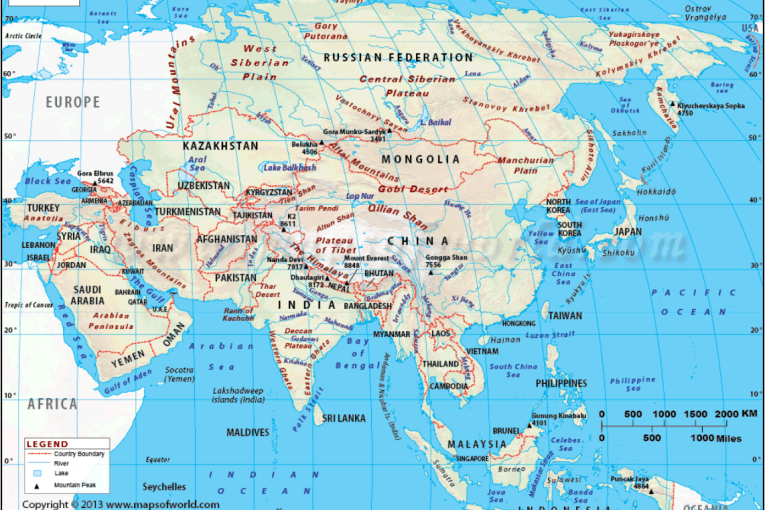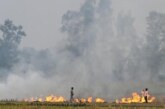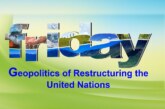
[“More people die from unsafe water than from all forms of violence, including war. These deaths are an affront to our common humanity, and undermine the efforts of many countries to achieve their development potential.” -Ban Ki-Moon, Secretary-General, United Nations]
 Linkages between water and indices of human development as the main drivers of economic growth and sustainable development are undeniable. Availability of safe drinking water and appropriate sanitation facilities are indispensable for the survival, health, growth and development of human beings.
Linkages between water and indices of human development as the main drivers of economic growth and sustainable development are undeniable. Availability of safe drinking water and appropriate sanitation facilities are indispensable for the survival, health, growth and development of human beings.
How growing threats to water security affects future progress in human development and economic growth of nations. The underlying concern is that water insecurity could decouple economic growth and progress in human development. The international development discourse is, however, characterized by unhealthy debates with divergent views. Though scholars have provided robust evidences to the effect that water security catalyses human development and economic growth, number of regions for which these evidences are available is too limited for a global consensus on this issue. Water poverty index (WPI), conceived and developed by Sullivan (2002), and the international comparisons now available from Laurence, Meigh and Sullivan (2003) for 147 countries enable us to provide an empirical basis for the argument.
In order to realistically assess the water situation of a country, which can capture the crucial attributes like access to water for various uses; level of use of water in different sectors; condition of the water environment; and technological and institutional capacities in water sector, a new index named Sustainable Water Use Index (SWUI) was derived from WPI. In this paper, the authors first analyze the nature of linkage between water situation of a country, vis-à-vis access and use, water environment and institutional capabilities in the water sector on economic growth. For this, data on sustainable water use index derived from WPI; human development and per capita GDP (ppp adjusted) for 145 countries, and data on global hunger index (GHI) for 117 countries are analyzed. In order to illustrate how creating water storages supports economic growth of countries which fall in hot and arid, tropical climates index, data on per capita dam storage were analyzed for 22 countries.
The regression analyses between SWUI and per capita GDP show that improving the water situation, vis-à-vis improved access to and use of water, institutional capabilities in water sector and improved water environment, through investments in water infrastructure, creating institutions and making policy reforms, can support economic growth of a nation. This is explained by the regression between SWUI and HDI, which showed that increase in SWUI raised the indicators of human development, paving the foundation for growth. This strong linkage can be partly explained by the reduction in malnutrition and infant mortality with improvement in water situation as indicated by the strong inverse relationship between SWUI and GHI. Whereas regression between per capita GDP and decomposed HDI shows that a country’s progress in human development has little to do with its economic prosperity, and that a country can achieve good indicators of development even at low levels of economic growth, through welfare oriented policies which encourage investments in water, health and education infrastructure. This means, economic growth is not a pre-requisite for solving water related problems. Instead, countries should invest in water infrastructure, institutions and policy reforms to achieve human development and sustain economic growth. Further analysis shows that hot and arid tropical countries, the investment in large water storages had helped support economic growth. Also, it seems to reduce malnutrition and incidence of child mortality. Finally, the study also provides a methodology for analyzing the linkage between water situation in a region and its economic growth.
It is ironic that at a time when many countries have met the MDG target for water supply and sanitation, South Asia still lacks in this regard. According to broad estimates, about a billion people do not use improved sanitation facilities and 700 million practice open defecation in South Asia and the pace of sanitation improvements has not kept up with population growth in the region. Such a sordid state of affairs can adversely affect the pace of human development in this part of the globe.
According to Mr. Ibrahim Thiaw Deputy Executive Director, UNEP “the issue of sanitation should be seen as a social, economic and environmental opportunity rather than a challenge & thus can afford revenue raising possibilities rather than being perceived as a cost and a burden on economies”, commented on 21 June 2014 at the Opening Session of the GMGSF-15 held at the UNEP’s headquarter.
Human development stands for the availability and provision of opportunities to the people to lead a healthy life. Clearly, the notion of human development is a holistic one – putting people at the centre of all development. The people are perceived to be the main actors as well as the beneficiaries of this process.
Water-Human Development Linkages
Water is key to sustainable human development because it entails all aspects of human life. Water plays significant role in fostering socio-economic development and human well-being. Water scarcity limits the ability to achieve full potential in terms of good health, education and livelihood.
Recurring incidents of water and climate-induced disasters, frequently transcending geographical boundaries, put have further strain on already scarce water resources. Water security in South Asia is under threat from many other factors: population growth, urbanization, increasing water pollution, the over-extraction of groundwater, water-related disasters, and climate change. The existing institutional mechanism at national and regional levels along with their current planning and management have proven insufficient to address the challenges of meeting diverse needs for water and environment sectors.
Its resultant impact is discernible in unsustainable growth in almost all sectors of economy and in the management of natural resources. This situation warrants apolitical solutions to water related problems with participation of civil society along with official level measures adhered to by respective governments of South Asia to bring the region on the trajectory of growth to translate the dream of 21st century as the century of South Asia. The role of water in human development is determined by a combination of critical factors such as availability of clean water, sanitation and economic growth.
South Asian Water Challenges
With more than 21 percent of the world’s population, the South Asia region has access to just over 8 percent of global water resources. Average water availability per capita across the region has declined considerably and continues to decrease. Burgeoning population along with intensified agricultural practices and irrigation; multiplying energy demand from greater industrial activity and economic growth; urbanization; complex environmental consequences of climate change, deteriorating river ecology, and deteriorating water quality in the regions’ surface and groundwater resources etc., continue to unfold new challenges for the region’s already scarce water resources. Current planning and management have proven insufficient to address these challenges of meeting South Asia’s diverse needs for water.
According to a report titled SAARC Regional Poverty Profile, released by the South Asian Association for Regional Cooperation (SAARC) in Kathmandu in early October 2013, though the South Asian region achieved an economic growth averaging 6.5 percent annually in 2000-12, this was not enough to reduce poverty and ensure food security. Lamenting that still 32 percent of South Asian people live on less than USD 1.25 per person a day, the Report underlined: “While some countries of the region may be near achieving the millennium development goal of halving the proportion of people in extreme poverty by 2015, the region in general has still high incidences of poverty, hunger and malnutrition.”
Water has come to assume unprecedented significance in South Asian development discourse. Water – its availability, consumption, distribution and impact on people’s lives and livelihoods – is closely associated to all the major challenges that the region faces now and will continue to face in the future as well. Declining water availability, food insecurity, environment degradation and unsustainable development are all closely related to or determined by water – its availability and usability.
Undoubtedly, South Asia is endowed with fair share of the world’s water resources; nevertheless, it experiences substantial temporal and spatial variability in per capita water availability. Besides, climate variability, in recent times, has rendered countries of the region vulnerable to severe droughts and intense floods, with irregular patterns of rainfall.
Re-engineering Water Governance
The hydro-social contract of the people with water is determined by the way in which water resources are harnessed. In view of the centrality and importance of water for daily survival, sustenance, livelihood opportunities and quality of life, it is necessary to acknowledge and recognize the different roles water plays in people’s lives and according to those roles, how they treat water.
Water is a primary human need and consequently it should be regarded as a human right that must be gradually realized by respective countries in the region. Commoditization of water spawns its inequitable distribution, especially for the poor who can ill-afford high water prices to be determined by market forces. And such a scenario would be illogical from a human development perspective.
There is a need for Paradigm Shift in the existing Water Discourse. As water is key to sustainable development and serves as a catalyst for human development, hence there is need to harness the full potentials of water for ensuring all-round development in South Asia by envisaging paradigm shift in water discourse.
In contemporary South Asia, the ongoing official and public discourse on water is reported to be highly political and motivated more by national and local interests than shared regional concerns. The current water management practices in vogue across the region are predominantly technical in nature. Water policy formulation and implementation has been dominated by engineers, scientists and ‘hydrocrats’ for decades. This overemphasis on technical aspects or hard approach to water management results in under representation of social and ecological perspectives.
Just as water is essential to human development, human development is key condition for sustainable management of water resources. A paradigm shift in approach to water management in South Asia is called for to have a more holistic understanding of water, placing it in its appropriate context and recognizing that it has multiple uses and multiple definitions.
The new policy shift should focus on equal emphasis on technical approach along with soft approach, an increased role for civil society in national and regional water discourse and formation of a Regional Water Hub to tackle trans-boundary water issues.
The role of civil society engagement on issues of water management has been almost negligible in South Asia. The multifaceted schemes in water sector that attract less public scrutiny are being preferred to high-cost, mega-projects by the governments of South Asian countries. Priority is being accorded to ‘privatized development rights’ on water and mobilized foreign investors to finance projects, circumventing the social and environmental review processes developed by the international financial institutions. This affords least opportunities for local communities to express their voice at the policy level.
The approach of Integrated Water Resources Management (IWRM), provided by the Global Water Partnership defines it as “coordinated development and management of water, land, and related resources,” can best help in maximizing sustainable use of water resources in the region. The involvement of civil society is a vital part of this process. Input from civil society and stakeholder groups can help address the social and ecological dimensions of water use, curb environmental degradation, and mitigate the potential for conflicts stemming from resource depletion. It can also help to reduce uncertainty in investment decisions and increase legitimacy for large-scale projects among affected communities by ensuring “buy-in” early in the decision-making process.
The recent 6th SAES’s Summit at Colombo, beyond highlighting the importance of moving towards a stronger, dynamic and inclusive South Asia, also centered around four key socio-economic policy areas termed ‘The Big Four’, which explored the significance of harnessing human capital through creating productive employment and addressing migrant dilemmas; managing water resources, ensuring food security and mitigating climate change addressing intra-country growth disparities.
Densely populated and disconnected South and South-West Asia rallied closely together on 28-29 November 2013, during the Policy Dialogue on Regional Cooperation, Connectivity and Inclusive Development which assembled some 100 participants from the 10 countries in the sub-region.
“Regional cooperation and economic integration could lead to more equitable and balanced patterns of development. It assumes a new criticality in the aftermath of the financial crisis, as developed economies are unable to drive the developing economies”, stated Dr. Nagesh Kumar, Chief Economist of ESCAP and Director, ESCAP-SSWA.
Gender equality and women’s empowerment, their access to productive resources and services as well as entrepreneurial opportunities, was another topic addressed during the two-day event, as key recommendations from the South Asia Policy Dialogue on Women’s Entrepreneurship held the previous day were presented at the Policy Dialogue. “Development, if not engendered is endangered”, stated Mr. Shafqat Kakakhel, Chairman, Sustainable Development Policy Institute, Islamabad, citing late Dr. Mahbub-ul Haq, and underlining that progress would not accelerate unless continuous, deliberate and affirmative actions were taken for women’s empowerment.
Initiatives of government of India
The advice from the Centre to the states comes in light of the Narendra Modi government’s stress on sanitation. The Centre has asked the states to step up the efforts to make the country open-defecation free by 2019 as that would be a “fitting tribute” to Mahatma Gandhi on his 150th birth anniversary that year. In a communication to the state chief secretaries, the Centre has sought better coordination between the Drinking Water and Sanitation departments to effectively deal with water and sanitation issues in rural areas. “To achieve ‘Swachh Bharat’, it may be better to have the same department at the state level to deal with water and sanitation issues,” it said. Yearly action by the states needs to be stepped up to at least three or four times that of the current levels in order to achieve the goal of ‘Swachh Bharat’ (Clean India), says the communication signed by Drinking Water and Sanitation Ministry Secretary Pankaj Jain. “In case that is not immediately possible, then better coordination between two departments at the state level may kindly be done,” it said. In his Independence Day speech, Modi pitched for efforts to build toilets to do away with the need for women to defecate out in the open. He urged parliamentarians and the corporate sector to help build separate toilets by next year for girls in schools across the country. “We are in the 21st century. Have we ever been pained by the fact that even today our mothers and sisters have to defecate in open? Dignity of women… isn’t that a responsibility of everybody? “Women and sisters wait for dusk. Until then they cannot relieve themselves. How much pain their body will be going through? How many diseases they must be prone to? Can’t we make provisions for a toilet for the dignity of our mothers and sisters,” Modi had said in his speech.
Meghalaya’s Water-Plus Model
Water Plus Initiative emphasizes on collective approach by Civil Society, International Organizations and the Government with focus on Human and Infrastructure development towards achieving inclusive and sustainable Meghalaya & North-East.
Meghalaya, located in the North-East region of India, has adopted the nexus approach as part of its Integrated Basin Development and Livelihoods Promotion Programme (IBDLP) launched in April 2012.
 The IBDLP programme, launched with inputs from India Water Foundation (IWF), a is designed around four pillars – Knowledge Management, Natural resource Management, Entrepreneurship Development and Good Governance and is being implemented in a mission mode through twenty two missions. Every mission is designed to leverage the comparative advantage that Meghalaya has in that sector and to generate livelihood opportunities for every household and to accelerate growth.
The IBDLP programme, launched with inputs from India Water Foundation (IWF), a is designed around four pillars – Knowledge Management, Natural resource Management, Entrepreneurship Development and Good Governance and is being implemented in a mission mode through twenty two missions. Every mission is designed to leverage the comparative advantage that Meghalaya has in that sector and to generate livelihood opportunities for every household and to accelerate growth.
Meghalaya has precise geographic and strategic assets for playing a vital role in promoting South-South Cooperation in Sustainable water and Human Development in cooperation with neighbouring states of North-East region of India and neighbouring countries of Bangladesh, Bhutan, Myanmar, Nepal and Thailand.
The Water Plus Initiative focuses on making incremental investments in the water bodies already created and also harnessing the best value from such investments by putting in place the approach of Integrated Water Resources Management (IWRM). The implementation strategy for the Water Mission was discussed, especially keeping in mind the various ongoing schemes and efforts of various departments to encouraged mobilizing resources from various schemes and programs including funding from international development funding agencies
Water is key to sustainable human development because it entails all aspects of human life. Water and Sanitation plays significant role in fostering socio-economic development and human well-being. Water scarcity impinges upon humans to achieve their full potential in terms of good health, education and livelihood. South Asia is emerging as a nerve Centre where populations and economies are being adversely impacted by poor water security. Just as water is essential to human development, human development is key condition for management of water resources and Sustainable Ecosystem Management through Environment Plus approach.
Additionally, the IWF’s Environment-Plus Model visualizes a holistic approach of integration of sustainable development into national policy at national, regional and global level. Sustainable development is a new paradigm for economic growth, social equality and environmental sustainability. Water is a key component of sustainable development and all ecosystems are inextricably linked with water.
Key elements of this approach inter alia include: capacity-building of sector and Actor through sensitization, incentivization and galvanization; Water-environment-energy-food nexus approach, establishment of a nodal agency as a hub for knowledge sharing and networking in water and environment sectors, assimilation and dissemination of water and environment related knowledge, inter-sectoral approach, equal emphasis on soft approach along with hard approach; and from sectoral to collective approach in water and environment sectors.
Key Stumbling Blocks
There are certain critical stumbling blocks to a closer cooperation among countries in South Asia in settling cross-border water issues for inclusive growth
- Lack of will on the part of political leadership;
- Absence of confidence-building measures in cross-border areas to improve livelihoods of the affected people;
- Negation of the role of the civil society;
- Absence of regional media’s role;
- Lack of mutual cooperation and coordination in tackling water related issues.
- Constructing security community in South Asia through water paradigm in mixed cohesion and cooperation.
As way forward under the given situation in South Asia, where future water scarcity entails potential of acting as a constraint on much needed development, cooperative management of water and environment sectors and human development is crucial to ensuring future growth with dignity.
Water resources and sanitation management requires a transformational shift to be effective and foster all stakeholders’ inclusive and collaborative partnership. To strengthening regional cooperation on water sharing to resolve water security issues in the region of South Asia, there is a need for the establishment of a Regional Water Hub in which all stakeholders of South Asia have equal representation.
Civil Society Organizations (CSOs) can serve as important conduits for fostering dialogue and linking grassroots issues to the negotiation process. Such endeavours would prove instrumental in the utilization of full potential of water as a catalyst for human development thereby ensuring long-lasting peace and prosperity of South Asia.
References
Asian Development Bank (ADB), Asian Water Development Outlook 2013: Measuring Water Security in Asia and the Pacific, Mandaluyong City, Philippines: ADB, 2013.
B.G, Verghese, “Water Issues in South Asia”, ORF Discourse, (New Delhi), Vol. 5, Issue-8, April 2011.
Muhammad Hanif, “Management of Water Resources in South Asia”, Science Vision, Vol. 7, No. 3&4, available at http://www.sciencevision.org.pk/BackIssues/Vol7/Vol7No3-4/Vol7No3&4_1_Management_of_Water_MHanif.pdf.
Human Development in South Asia 2013 – Issue of water from the perspective of human development/ http://mhhdc.org/wp-content/themes/mhdc/reports/HDSA-2013.pdf
Human Development in South Asia 2012 – Governance for People’s Empowerment/ http://mhhdc.org/?p=40
UN-ESCAP, The Status of the Water-Food-Energy Security Nexus in Asia and the Pacific, 15 March 2013.
UNDP, Human Development Report 2006, Beyond Scarcity: Power, poverty and global water crisis, New York: UNDP, 2006.
World Economic Forum (WEF), Water Security: The Water- Food -Energy-Climate Nexus, Washingtol: OIsland Press, 2011.
WWF, “WWF’s Living Himalayas Initiative Factsheet”, 28 September 2011, available at http://wwf.panda.org/?201790/Living-Himalayas-Factsheet
http://www.pwc.in/en_IN/in/assets/pdfs/publications/2013/north-east_summit-2013.pdf
http://siteresources.worldbank.org/SOUTHASIAEXT/Resources/223546-1168296540386/VolumeI.pdf
CIPE Pakistan Activities Report 2013/ http://www.cipe.org/sites/default/files/publication-docs/CIPE%20Pakistan%20Activity%20Report%202013.pdf
Kumar, Arvind (2014), Mainstreaming India’s North-East, SME World, January.
Kumar, Arvind (2014), regional connectivity for shared prosperity in north-east india challenges and opportunities for south and south-east asia/ TECH MONITOR • Jan-Mar 2014
Kumar, M. Dinesh, Z. Shah, Sacchidananda Mukherjee and Arun Mudgerikar (2008), “Water, Human Development and Economic Growth: Some International Perspectives“, in the proceedings of the IWMI-Tata Water Policy Research Program’s Seventh Annual Partners’ Meet, “Managing Water in the Face of Growing Scarcity, Inequity and Declining Returns: Exploring Fresh Approaches”, ICRISAT Campus, Patancheru, April 2-4, 2008, Vol. 1, pp. 842-858./ http://works.bepress.com/sacchidananda_mukherjee/36/
http://www.thehindubusinessline.com/news/states/opendefecation-centre-for-linking-water-sanitation-departments/article6325793.ece
Bio-Data
Dr Arvind Kumar is a renowned water activist, having provided new impetus to the water movement in India by disseminating knowledge on water-related issues with specific emphasis on Right to Water, Water Rights for Socially Excluded, Inter-Sectoral Convergence in Water Sector and Regional Water Diplomacy etc. He is the President of India Water Foundation, a non-profit organization established for the purpose of generating a heightened public awareness at national level in India and sub-regional level in Asia, regarding water and its impact on human health, economic growth and environmental sustainability.
He holds PhD in Defense Studies and commands rich and varied administrative and managerial experience. He is a renowned political commentator, frequently contributing articles on contemporary political, socio-economic, environmental and defense related issues in prominent journals. He has published over 250 plus research articles in recent years on national, regional and international issues in reputed journals. He is Editor with SAR Economist monthly magazine and online e-Magazine Focus Global Reporter being published from New Delhi, India.
_____________________________________________
Published in AIPA- Leadership Insight (October 13, 2014)



